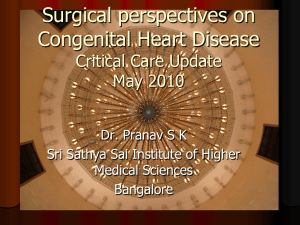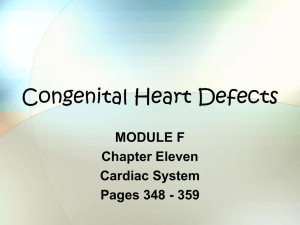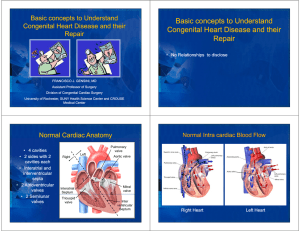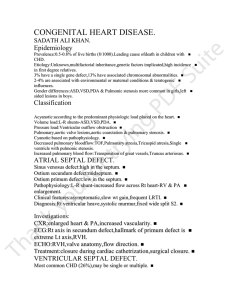Cardiovascular Pathophysiology: Left To Right Shunts
advertisement
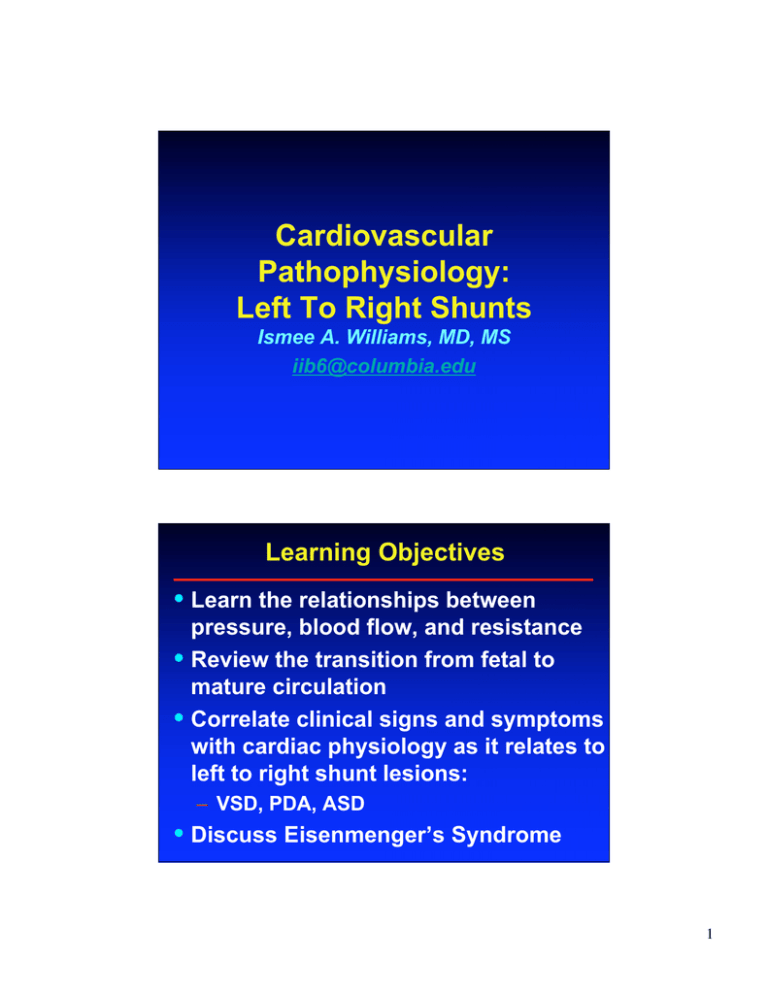
Cardiovascular Pathophysiology: Left To Right Shunts Ismee A. Williams, MD, MS iib6@columbia.edu Learning Objectives • Learn the relationships between • • pressure, blood flow, and resistance Review the transition from fetal to mature circulation Correlate clinical signs and symptoms with cardiac physiology as it relates to left to right shunt lesions: – VSD, PDA, ASD • Discuss Eisenmenger’s Syndrome 1 Pressure, Flow, Resistance • Perfusion Pressure: Pressure gradient across vascular bed – ! Mean Arterial - Venous pressure • Flow: Volume of blood that travels • across vascular bed Resistance: Opposition to flow – Vessel diameter – Vessel structure and organization – Physical characteristics of blood Poiseuille equation Q = !P"r4 8nl R =8nl "r4 !P = pressure drop r = radius R = !P Q n = viscosity l = length of tube Q = flow 2 Hemodynamics Flow (Q) = ! Pressure Resistance Resistance = ! Pressure Flow Two parallel fetal circulations ! Placenta supplies oxygenated blood via ductus venosus ! Foramen ovale directs ductus venous blood to left atrium (40%) ! Pulmonary blood flow minimal (<10%) ! Ductus arteriosus allows flow from PA to descending aorta (40%) 3 Ductus Venosus and Streaming • Ductus venosus diverts O2 blood through liver to IVC and RA – Amount varies from 20-90% • Streaming of blood in IVC – O2 blood from the DV!FO!LA!LV – De-O2 blood from R hep, IVC !TV! RV • SVC blood flows across TV!RV – <5% SVC flow crosses FO O2 blood to high priority organs • RV pumps De-O2 blood to PA!DA! DescAo ! lower body and placenta • LV pumps O2 blood to AscAo! coronary + cerebral circ • Aortic isthmus connects the two separate vascular beds 4 Fetal Shunts Equalize Pressure • RAp = LAp due to FO • RVp = LVp due to DA Unlike postnatal life unless a large communication persists… RV is “work horse” of fetal heart • RV pumps 66% CO – 59% goes to DA • (88% RV CO) – 7% goes to lungs • (12% RV CO) • LV pumps 34% CO – 31% goes to AscAo • Only 10% total CO crosses Ao isthmus 5 Transition from Fetal to Neonatal Circulation • Lose placenta – "SVR • Lungs expand mechanically • "O2 vasodilates pulm vasc bed – #PVR • " PBF + "LA venous return – "LAp • DV constricts – #RAp Three Fetal Shunts Close • LAp > RAp – FO closure • "O2 and # PGE1 – DA and DV constrict • RV CO # – RV wall thickness # • LV CO " – LV hypertrophies RV CO = LV CO Postnatal circulation in series 6 Regulation of Pulmonary Vascular Tone • Vascoconstriction • – Hypoxia/acidosis – High blood flow and pressure – Failure of vessel maturation (no regression of medial hypertrophy) Vasodilation – Improved oxygenation – Prostaglandin inhibition – Thinning of vessel media (regression of medial hypertrophy) Fetal Pulmonary Vascular Bed • • Placenta is the organ of gas exchange Goal to bypass the fetal lungs • Pulmonary Pressure >> Ao Pressure – Low O2 tension causes Vasoconstriction – Medial wall hypertrophy Pulmonary blood flow << Ao flow Pulmonary resistance >> Ao resistance – Encourages shunting via DA to aorta • • 7 Neonatal Pulmonary Vascular Bed • Pulmonary Pressure # Ao Pressure – Arterial vasodilation – Medial wall hypertrophy persists • Pulmonary Blood flow = Aortic Flow – Ductus arteriosus closes – Neonatal RV CO = LV CO • Pulmonary resistance # Ao Resistance Adult Pulmonary Vascular Bed • Pulmonary Pressure << Ao Pressure – 15 mmHg vs. 60 mmHg – Arterial Vasodilation – Medial wall hypertrophy regresses remodeling • Pulmonary Blood Flow = Aortic Flow • Pulmonary Resistance << Ao Resistance – Resistance = ! Pressure Flow 8 Pulmonary Vascular Bed: Transition from Fetal to Adult R= !P Q Re-Cap: Fetal to Postnatal • Fetus – – – – Shunts exist Lungs collapsed RV CO > LV CO (Parallel circ) Pulmonary pressure and resistance high • Newborn – – – – Shunts close Lungs open RV CO = LV CO (Series circ) Pulmonary pressure and resistance drop 9 Left to Right Shunts • Anatomic Communication between Pulmonary and Systemic circulations • Excess blood flow occurs from the Systemic (Left) to the Pulmonary (Right) circulation Qp:Qs • Extra flow is represented by the • • • • ratio of pulmonary blood flow (Qp) to systemic blood flow (Qs) Qp:Qs = 1:1 if no shunts Qp:Qs >1 if left to right shunt Qp:Qs <1 if right to left shunt Qp:Qs of 2:1 means pulmonary blood flow is twice that of systemic blood flow 10 Why do we care? • Already oxygenated pulmonary venous • • • blood is recirculated through the lungs Excess PBF causes heart failure (CHF) Size of the shunt and $ the amount of PBF (Qp) determine how much CHF Shunt size determined by: – – – – Location of communication Size of communication Age of the patient Relative resistances to blood flow on either side of the communication Pulmonary Effects of L to R Shunt • " PBF = " extravascular lung fluid – transudation of fluid across capillaries faster than lymphatics can clear • Altered lung mechanics – Tidal volume and lung compliance # – Expiratory airway resistance " • Pulmonary edema results if Qp and • Pulm Venous pressure very high Tachypnea 11 Neurohumoral Effects of L to R Shunt • Sympathetic nervous system and renin-angiotensin system activation – plasma [NE] and [Epi] " – cardiac hormone B-type natriuretic peptide (BNP) " • Tachycardia • Diaphoresis Metabolic Effects of L to R Shunt • Acute and chronic malnutrition • Mechanism not clear – " metabolic expenditures (" O2 consumption) due to " respiratory effort and myocardial work – # nutritional intake • Poor growth/ Failure to thrive 12 Pulmonary Hypertension: End Stage • " PBF causes sustained " PAp • Pulm vascular bed fails to remodel – Alveolar hypoxia may exacerbate • Gradual effacement of the pulm arterioles – Overgrowth of vascular smooth muscle – Intimal proliferation • Abnormal local vascular signaling • Impaired endothelial function • Pulm bed loses normal vasoreactivity – fixed pulmonary HTN and irreversible pulmonary vascular disease Re-Cap • • • Flow, Resistance, Pressure Fetal and Transitional Circulation Left to Right Shunts and CHF • • • • • VSD PDA AVC ASD Eisenmenger 13 “Top 4” Left to Right Shunt Lesions • Ventricular Septal Defect (VSD) – Left ventricle to Right ventricle • Patent Ductus Arteriosus (PDA) – Aorta to Pulmonary artery • Atrioventricular Canal Defect (AVC) – Left ventricle to Right ventricle – Left atrium to Right atrium • Atrial Septal Defect (ASD) – Left atrium to Right atrium VSD most common CHD (20%) • 2/1000 live births • Can occur anywhere in the IVS • Location of VSD has no effect on shunt • Perimembraneous most common (75%) • Muscular (15%) most likely to close • Outlet (5%) most likely to involve valves – " incidence in Asian pop (30%) • Inlet (5%) assoc with AVC 14 Ventricular Septal Defect VSD: Determinants of L to R shunt • Size of VSD • Difference in • resistance between Pulmonary and Systemic circulations Difference in pressure between RV and LV 15 VSD: Determinants of L to R shunt • Small (restrictive) VSD: L to R shunt flow limited by size of hole • Large (unrestrictive) VSD: L to R shunt flow is determined by Pressure and Resistance – If RVp < LVp, L to R shunt occurs – If RVp = LVp, L to R shunt occurs if pulmonary < aortic resistance • Shunt flow occurs in systole Transitional Circulation: Effects on L to R shunt in large VSD • Fetus: bidirectional • • shunt At Birth: No shunt Transition 1-7 wks – PA/RVp $ to < LVp – PA resistance $ to < Systemic – L to R shunt % 16 Large VSD: Hemodynamic Effects • • • Flow LV! RV! PA • " LV SV initially by Starling mechanism • " LV dilation leads to systolic dysfxn & CHF " Pulm circ leads to pulm vascular disease • " Pulm Venous Return LA/LV volume overload VSD: Signs/Symptoms • Asymptomatic at birth: PA = Ao • Pressure and Resistance Signs of congestive heart failure as pulmonary pressure and resistance $ – Poor feeding – Failure to thrive (FTT) with preserved height and low weight – Tachypnea – Diaphoresis – Hepatomegaly – Increased respiratory illness 17 VSD: Physical Exam • Harsh Holosystolic murmur – loudest LLSB radiating to apex and back – Smaller VSD = louder murmur • • • • Precordial Thrill 2° turbulence across VSD Mid-Diastolic rumble 2° " trans-Mitral flow LV heave 2° LV dilation Signs of CHF – Gallop (S3), Hepatomegaly, Rales • Signs of Pulm Vasc Disease – #murmur, RV heave, loud S2, cyanosis VSD: Laboratory Findings • CXR: Cardiomegally, "PVM – Pulm Vasc Dz: large PAs • EKG: LAE, LVH – Pulm Vasc Dz: RVH • ECHO: Location/Size VSD – Amount/direction of shunt – LA/LV size – Estimation RV pressure • CATH: only if suspect "PVR – O2 step up in RV 18 VSD: Electrocardiogram VSD: CXR 19 VSD: Echocardiogram VSD: Angiogram 20 VSD: Management • Does the patient have symptoms? – size of the defect, RV/LV pressure, Pulm/Ao resistance • Will the VSD close or #in size? • Is there potential for complications? – Valve damage, Pulm HTN • Will the surgery be difficult? Will the surgery be successful? VSD: Management • • • Medical – Digoxin – Lasix – Increased caloric intake – 50% VSD size $ and CHF resolves Surgical – Persistent CHF – % pulmonary vascular resistance – Valve damage – Within first two years of life Catheter 21 VSD: Endocarditis Prophylaxis • Not for isolated VSD • Yes for 1st 6 mo following repair of • • VSD with prosthetic material or device Yes for life if there is a residual defect at or adjacent to the site of a prosthetic device For dental and respiratory tract procedures ONLY – no longer for GI or GU procedures Patent Ductus Arteriosus (PDA) • Communication between Aorta and Pulmonary Artery • 1/2500-5000 live births • Risk factors: prematurity, rubella, high altitude 22 PDA: Determinants of L to R shunt • Magnitude L to R shunt depends on – Length and diameter of ductus – Relative resistances of Ao and PA • " L to R shunt as Pulm resistance # – Volume overload of PA, LA, LV • Shunt flow occurs in systole and diastole PDA: Signs/Symptoms • Small PDA: asymptomatic • Large PDA: CHF – – – – – – Diaphoresis Tachypnea Poor feeding FTT Hepatomegaly Respiratory infections • Moderate PDA: Fatigue, Dyspnea, palpitations in adol/adults – Afib 2º to LAE 23 PDA: Physical Exam • Continuous machine-like murmur at left subclavian region – Ao>PA pressure in systole and diastole • Congestive heart failure PDA: Laboratory Studies • CXR: cardiomegally, " PVM • EKG: LAE, LVH • ECHO: measures size PDA, shunt and gradient, estimate PAp • CATH: O2 step up in PA 24 PDA: Management • Indications for Closure – CHF/failure to thrive – Pulmonary hypertension • Closure Methods – Indomethacin if preemie – Surgical ligation – Transcatheter closure • Coil • Device PDA Coil Closure 25 Atrioventricular Canal Defect/ Endocardial Cushion Defect • Atrial Septal Defect (Primum) • Inlet VSD • Common Atrioventricular Valve AVC: Management • Closure always indicated • Timing of surgery (elective by 6 mos.) • – Congestive Heart Failure • Large left to right shunt • Mitral insufficiency – Pulmonary hypertension Surgical repair – ASD, VSD closure – Repair of AV-Valves 26 Summary: VSD, PDA and AVC • Asymptomatic in fetus and neonate • Progressive % in L to R shunt from 3-8 • wks of life as pulmonary pressure and vascular resistance $ Indications for intervention – Congestive heart failure: FTT – Pulmonary vascular disease • End stage: Eisenmenger’s syndrome Atrial Septum Formation • Septum Primum grows downward • Ostium Primum obliterates • Fenestration in septum primum • forms ostium secundum Septum secundum grows downward and fuses with endocardial cushions – Leaves oval-shaped opening Foramen ovale • Superior edge of septum primum regresses – Lower edge becomes flap of FO 27 Atrial Septal Defect • Persistent communication between RA • and LA Common: 1/1500 live births – 7% of CHD • Can occur anywhere in septum • Physiologic consequences depend on: – Location – Size – Association with other anomalies Atrial Septal Defect (ASD) 28 ASD Types • Ostium Secundum ASD (70%) – 2:1 F>M – Familial recurrence 7-10% • Holt-Oram syndrome - upper limb defects – Region of FO – Defect in septum primum or secundum • Ostium Primum ASD – Inferior portion of septum – Failure of fusion between septum primum and endocardial cushions – Cleft in MV or CAVC ASD Types • Sinus Venosus ASD (10%) – Incomplete absorption of sinus venosus into RA • IVC or SVC straddles atrial septum – Anomalous pulmonary venous drainage • Coronary Sinus ASD – Unroofed coronary sinus – Wall between LA and coronary sinus missing – Persistent L-SVC 29 Patent Foramen Ovale • Prevalence 30% of population • Failure of fusion of septum primum and secundum (flap of FO) • Remains closed as long as LAp>RAp – LAp<RAp • Pulmonary HTN / RV failure • Valsalva – Paradoxical embolism and STROKE ASD: Manifestations • L to R shunt between LA and RA – Amount of flow determined by: • Size of defect • Relative compliance of RV / LV – Shunt flow occurs only in diastole – L to R shunt " with age • RV compliance " • LV compliance # • RA and RV volume overload 30 ASD: Signs/Symptoms • Infant/child usually asymptomatic – DOE, fatigue, lower respiratory tract infections • Adults (prior age 40) – Palpitations (Atrial tach 2º RAE) – # stamina (Right heart failure) – Survival less than age-matched controls (5th-6th decade) ASD: Physical Exam • Small for age • Wide fixed split S2 • RV heave • Systolic murmur LUSB – % flow across PV • Mid-Diastolic murmur LLSB – % flow across TV 31 ASD: Laboratory Studies • CXR: cardiomegally, " PVM • EKG: RAD, RVH, RAE, IRBBB – Primum ASD: LAD • ECHO: RAE, RV dilation, ASD size, location, amount and direction of shunt • CATH: O2 step up in RA ASD: Management • Indications for closure – RV volume overload – Pulmonary hypertension – Thrombo-embolism • Closure method – Surgical – Catheter Delivered Device • Cardioseal • Amplatzer septal occluder 32 Eisenmenger’s Syndrome • • • • Dr. Victor Eisenmenger, 1897 Severe pulmonary vascular obstruction 2º to chronic left to right shunts Pathophysiology – High pulmonary blood flow& Shear Stress – Medial hypertrophy + intimal proliferation leads to #cross-sectional area of pulm bed – Perivascular necrosis and thrombosis – Replacement of normal vascular architecture Pulmonary vascular resistance increases – Right to left shunt – Severe cyanosis Medial Hypertrophy 33 Eisenmenger’s Syndrome R to L flow via VSD • Pressure: – Pulmonary = Aortic • Resistance – Pulmonary > Aorta • • • • RV hypertrophy Blood flow: RV to LV Cyanosis Normal LA/LV size Eisenmenger’s: Signs/Symptoms • Infancy: • – CHF improves with # left to right shunt Young adulthood: – Cyanosis/Hypoxia: DOE, exercise intolerance, fatigue, clubbing – Erythrocytosis/hyperviscosity: H/A, stroke – Hemoptysis 2º to infarction/rupture pulm vessels 34 Eisenmenger’s: Physical Exam • Clubbing • Jugular venous a-wave pulsations – "RV pressure during atrial contraction • Loud S2 • RV heave (RV hypertension) • Diastolic pulm insufficiency murmur • No systolic murmur Eisenmenger’s: Lab findings • No LV volume overload / " RV pressure • CXR: Clear lung fields, prominent PA segment with distal pruning, small heart • EKG: RAE, RVH ± strain • ECHO: RV hypertrophy, right to left shunt at VSD, PDA, or ASD 35 EKG: Eisenmenger’s Syndrome Eisenmenger’s Syndrome: CXR 36 Eisenmenger’s: Management • Avoid exacerbating right to left shunt – No exercise, high altitude, periph vasodilators – Birth Control: 20-40% SAB, >45% mat mortality • Medical Therapy: – Pulmonary vasodilators: Calcium channel blocker, PGI2, Sidenafil – Inotropic support for Right heart failure – Anticoagulation • Transplant – Heart-Lung vs Lung transplant, heart repair • Do NOT close Defect – VSD/PDA/ASD must stay open – Decompress high pressure RV, prevent RV failure and provide cardiac output Learning Objectives • Learn the relationships between • • pressure, blood flow, and resistance Review the transition from fetal to mature circulation Correlate clinical signs and symptoms with cardiac physiology as it relates to left to right shunt lesions: – VSD, PDA, ASD • Discuss Eisenmenger’s Syndrome 37
